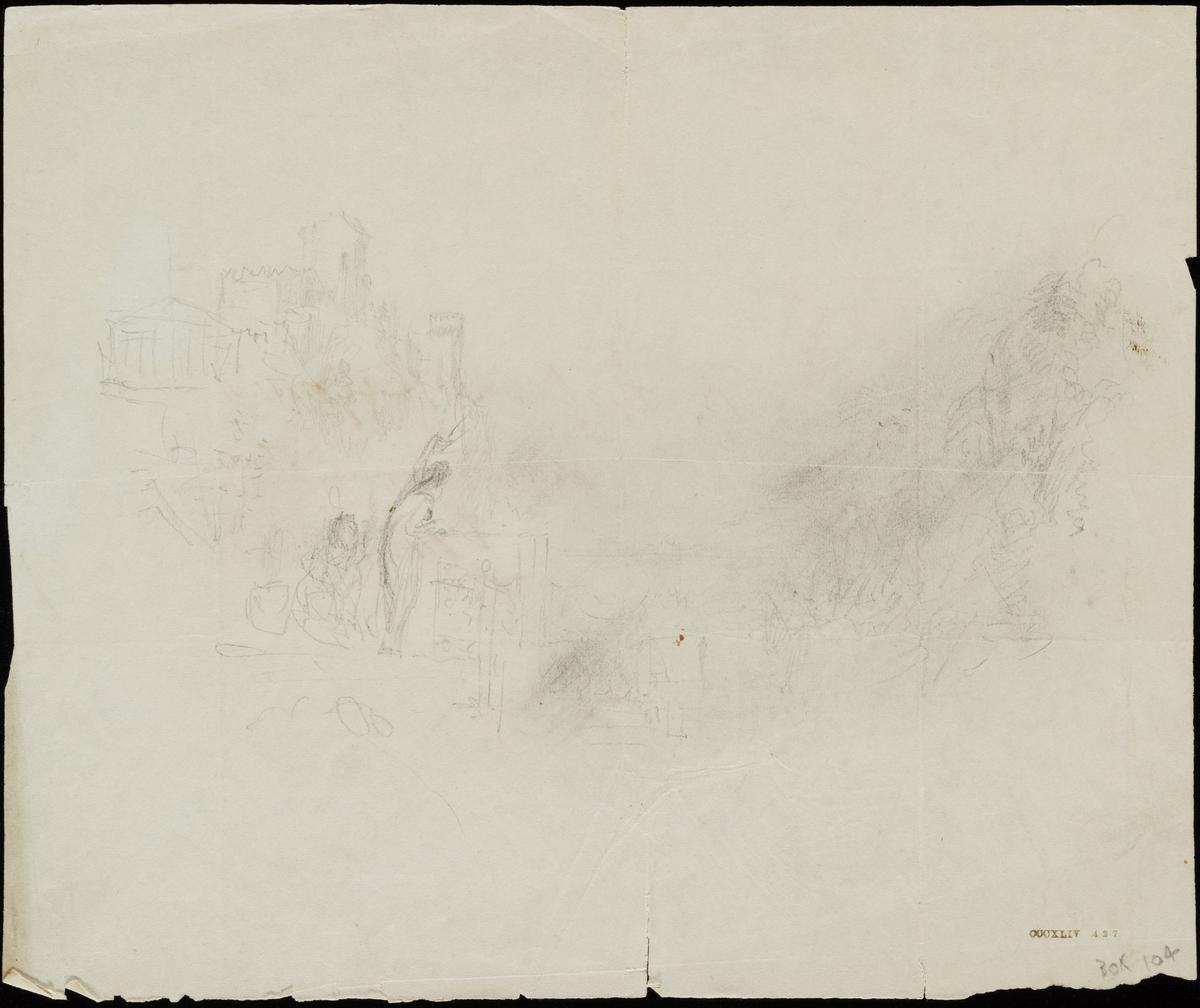Joseph Mallord William Turner Study for 'The Parting of Hero and Leander' c.1837
Image 1 of 2
Joseph Mallord William Turner,
Study for 'The Parting of Hero and Leander'
c.1837
Joseph Mallord William Turner 1775–1851
Study for ‘The Parting of Hero and Leander’ c.1837
D34924
Turner Bequest CCCXLIV 427
Turner Bequest CCCXLIV 427
Pencil on white wove paper, 186 x 224 mm
Stamped in black ‘CCCXLIV 427’ bottom right
Inscribed in pencil ‘Box 104’ bottom right
Stamped in black ‘CCCXLIV 427’ bottom right
Inscribed in pencil ‘Box 104’ bottom right
Accepted by the nation as part of the Turner Bequest 1856
References
1830
A.J. Finberg, A Complete Inventory of the Drawings of the Turner Bequest, London 1909, vol.II, p.1149, CCCXLIV 427, as ‘Study for “Hero and Leander.”’, c.1830–41.
1966
Jack Lindsay, J.M.W. Turner: His Life and Work, London 1966, p.246 note 8.
1984
Martin Butlin and Evelyn Joll, The Paintings of J.M.W. Turner, revised ed., New Haven and London 1984, p.221 under no.370.
1990
Kathleen Nicholson, Turner’s Classical Landscapes: Myth and Meaning, Princeton 1990, p.197.
1998
Judy Egerton, The British Paintings, National Gallery Catalogues, London 1998, p.298.
As Finberg recognised,1 this relatively slight drawing is presumably a direct study for the large mythological painting The Parting of Hero and Leander – from the Greek of Musaeus, exhibited at the Royal Academy in 1837 (Turner Bequest, National Gallery, London).2 Turner had been interested in the subject for many years, as there is a recognisably similar composition in chalks, inscribed ‘Hero and Leander’, in the Calais Pier sketchbook (Tate D04959; Turner Bequest LXXXI 57), which had been in use at the turn of the century.
The 1816 Yorkshire 1 sketchbook includes a tonal pencil study (Tate D11036; Turner Bequest CXLIV 103a), and there is a sight but apparently related drawing in the River sketchbook of about 1823–4 (Tate D17828; Turner Bequest CCIV 39). Complex architectural drawings in the Mouth of the Thames sketchbook of about 1832 (Tate D27227–D27228; Turner Bequest CCLXXVIII 1a, 2) have been linked to the painting.3 There is also an oil sketch, probably made around 1827–8 (Tate N03381),4 which appears to develop the arrangement of the Calais Pier drawing, introducing prominent if rather incongruous trees at the centre of the coastal scene.
All the above studies vary significantly from the arrangement of the final composition. The present drawing is much closer, even while differing in precise detail (the portico of the temple would be elevated to the very top, for example), and was perhaps made at an early stage in Turner’s work on the canvas, where the details would have evolved out of broad lay-ins of tone and colour. The dark patch at the bottom centre corresponds to the point in the painting where the lovers Hero and Leander are shown by the shore, while rubbing over the vaguely defined forms at the right might be the genesis of the foam-like, glowing array of sea nymphs at that point in the moonlit scene.
In view of speculation that The Parting of Hero and Leander may have been in progress over some years, Martin Butlin and Evelyn Joll have concluded after technical analysis that it was instead produced ‘rapidly’, presumably not long before being shown, and ‘not heavily reworked’.5 It was first exhibited in 1837, and the present working drawing is here dated accordingly, although it was made on the back of a letter (Tate D40449) which appears to date from around 1823.
Technical notes:
The sheet initially served as an envelope, and was folded numerous times; there is slight tearing along the creases at the top and bottom edges.
Matthew Imms
August 2016
How to cite
Matthew Imms, ‘Study for ‘The Parting of Hero and Leander’ c.1837 by Joseph Mallord William Turner’, catalogue entry, August 2016, in David Blayney Brown (ed.), J.M.W. Turner: Sketchbooks, Drawings and Watercolours, Tate Research Publication, February 2017, https://www


